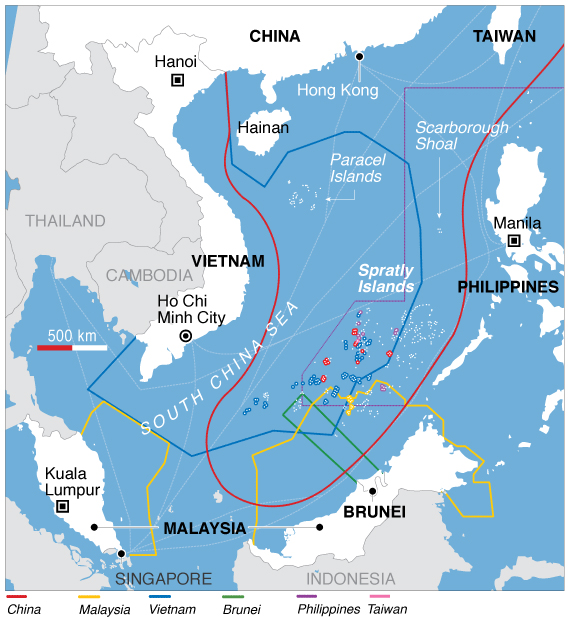Dispute in the South China Sea: A Legal Primer
Although the United States will often urge the claimants to resolve the South China Sea dispute in accordance with “international law” writ broadly, the conflict is governed in reality by a number of different bodies of international law. Building on the historical backgrounder in an earlier post, I will lay out here the two primary legal quarrels at the core of the South China Sea conflict: the dispute over territory and the dispute over the substance and application of maritime law.

Published by The Lawfare Institute
in Cooperation With

Although the United States will often urge the claimants to resolve the South China Sea dispute in accordance with “international law” writ broadly, the conflict is governed in reality by a number of different bodies of international law. Building on the historical backgrounder in an earlier post, I will lay out here the two primary legal quarrels at the core of the South China Sea conflict: the dispute over territory and the dispute over the substance and application of maritime law.
Territorial Dispute
In the South China Sea dispute, the claimants are squabbling first and foremost over sovereignty over the Sea’s territorial features. At its most basic, the claimants disagree over who owns each of the features. Some claimants—like Brunei and Malaysia—have advanced relatively modest territorial claims. Others—like the Philippines and especially Vietnam—have asserted ownership over a much larger proportion of the Sea’s features. Finally, China (and Taiwan) have laid claim to every piece of territory in the entire Sea. (See picture above for a map of these overlapping claims.)
To back up their claims, the six states have relied on the law of sovereignty. A bit of background: the law of sovereignty is part of customary international law, and it originally prescribed five different methods of acquiring sovereignty over territory. One of those methods—conquest—is no longer consider lawful (Crimea notwithstanding), but it remains potentially relevant as the historical source of authority for some of the disputants’ claims. The other four methods continue to be recognized today. States can gain territory through the process of accretion, or the expansion of existing territory through natural processes like volcanic eruptions. States can also transfer sovereignty over territory to each other through the process of cession. If a state discovers and then effectively occupies new territory (known as terra nullius), then it can acquire sovereignty over that unclaimed territory through the process of effective occupation. Finally, a state can gain sovereignty over another state’s territory by occupying it publicly, peacefully, and uninterruptedly for a sufficiently long time. This process is called prescription, and it mirrors the doctrine of adverse possession in American property law.
Notably, sovereignty law does not put stock in the proximity of a state to its territorial claims. As I’ve noted before, the Permanent Court of Arbitration held in the highly influential Island of Palmas case that “it is impossible to show the existence of a rule of positive international law to the effect that islands situated outside territorial waters should belong to a State from the mere fact that its territory forms the terra firma (nearest continent or island of considerable size).” So while it may seem absurd to many that Beijing may have a stronger claim than Manila to an island right off the Philippine coast, that outcome is not foreclosed by the law of sovereignty. (Indeed, consider the case of the United States and Alaska or Hawaii.)
In the South China Sea, the six claimants have mixed and matched sovereignty law’s doctrines in order to stitch together legally convincing claims. Some claimants, like China and Vietnam, have tried to unearth a long history of effective occupation by their national predecessors. Vietnam has also tried to justify its ownership by tracing title back to its colonial occupier, France. In contrast, the Philippines has argued that—whatever the history of Chinese and Vietnamese use—the Spratly Islands were abandoned by the time that Philippine citizen Thomas Cloma stumbled upon them in the 1950s, and that Cloma was able to acquire and then transfer sovereignty over them to the Philippines.
Sifting through these claims is a Herculean task, and one that may prove impossible in the end. Indeed, after surveying the available evidence, Bill Hayton argues that the legal question itself makes no conceptual sense—the Western idea of “sovereignty” or “ownership” simply does not translate into the historical context of the South China Sea, where sovereignty was often overlapping, graduated, or patchy. As a result, “[i]n no sense did any state or people ‘own’ the Sea.”
In any event, the claimants have shown little appetite thus far for handing over the territorial issues in the South China Sea dispute to an impartial tribunal, perhaps because no claimant is especially confident in their legal justifications. As a result, the territorial issue seems most likely to be resolved ultimately on the basis of a political settlement rather than a legal ruling.
The parties are far from beginning serious negotiations on this score, however. China insists on bilateral negotiations, while the smaller claimants favor multilateral talks where they can band together to counteract their northern neighbor’s heft. For now, then, the legal issue is likely to remain overshadowed by changing events on the ground.
Maritime Dispute
Alongside the territorial dispute, the claimants have also clashed over issues related to maritime law. Whereas sovereignty law governs who may exert full sovereignty over the territorial features of the South China Sea, maritime law governs what jurisdiction states may exert over the nearby waters and the seabed underneath. So, for instance, the United States has sovereignty over the territory of Hawaii, but it is maritime law that decides the extent of its offshore jurisdiction. Because maritime law reaches beyond the disputed territories, it has pulled a variety of other parties into the vortex of the South China Sea dispute (including Indonesia and the United States).
Maritime law has largely been codified in the U.N. Convention on the Law of the Sea (UNCLOS). The vast majority of nations have ratified UNCLOS, including all the primary claimants in the South China Sea dispute. While the treaty has not yet been ratified by the United States, Washington has made clear that it sees most of the treaty’s substantive provisions as reflecting customary international law binding on all countries.
Yet despite the high degree of consensus surrounding UNCLOS, there are several statutory ambiguities or gaps that have precipitated contested interpretations by the claimants.
To begin with, the claimants disagree about the scope of jurisdiction that UNCLOS entitles them to over the South China Sea’s waters. In particular, the claimants have different views about the boundaries of the various national exclusive economic zones (EEZs) and continental-shelf zones. Part of the disagreement stems from the territorial dispute—maritime zones are drawn from a territorial baseline, so without agreement over that baseline, states will disagree about the size and shape of the zones. But the disagreement also stems from differences of opinion about how UNCLOS classifies each of the territorial features. Under UNCLOS, certain territorial features are entitled to greater maritime zones than others, as I’ve explained in greater depth before. So for example, if a feature (1) surfaces above the ocean at high tide, and (2) can “sustain human habitation or economic life of [its] own,” then it is entitled to a 200-nautical-mile EEZ, in which the sovereign may “explor[e] and exploit[], conserv[e] and manag[e] the natural resources, whether living or non-living, of the waters superjacent to the seabed and of the seabed and its subsoil,” among other rights. Because the claimants disagree over how to classify the territorial features of the South China Sea (for instance, whether they can sustain human habitation or economic life of their own), they also disagree about the scope and type of the attached maritime zones.
Many of these issues are playing out in the Philippines’s arbitration case against China. In January 2013, Manila sued China for breaching the provisions of UNCLOS. In its case, the Philippines is making three primary claims, all related to maritime jurisdiction: first, that Beijing claims more of the South China Sea’s waters than the Convention permits; second, and relatedly, that China has claimed 200-nautical-mile EEZs for a number of insular features not entitled to them; and third, that China has violated other rights guaranteed to the Philippines by UNCLOS. Right now, the tribunal is still deciding on its own jurisdiction to hear the case—Beijing argues that the maritime issues are too entwined with the territorial ones to be capable of resolution on their own—but if the court moves to the merits, then it may deal a serious blow to China’s maritime claims as encapsulated in the infamous nine-dash line.
Besides quarrels over the scope of EEZs and the like, the South China Sea parties also feud over the rights that states have within those maritime zones. In particular, the United States and China have offered competing interpretations of the lawfulness of foreign military activities in another country’s EEZ. Relying on a variety of UNCLOS provisions and security-based arguments, Beijing contends that these “hostile” activities breach the letter and spirit of the Convention. The United States disagrees. According to it, military activities in another country’s EEZ are supported by a long history of state practice, and nothing in the Convention purports to prohibit them. (Beijing may be warming to this view—recently, it collected intelligence in the United States’s EEZ—but it has not officially altered its views yet.) This interpretational difference has provoked crises in the past: the American military often collects intelligence in China’s EEZ, and Beijing has occasionally tried to interfere with those activities—sometimes with serious consequences.
* * *
None of these legal issues is likely to disappear any time soon. The underlying drivers of the conflict are simply too powerful to let the legal issues be resolved without some parallel political compromise. Nevertheless, the legal issues continue to frame the dispute in important ways, and must be dealt with on the way to any long-term solution.


.jpg?sfvrsn=407c2736_6)


